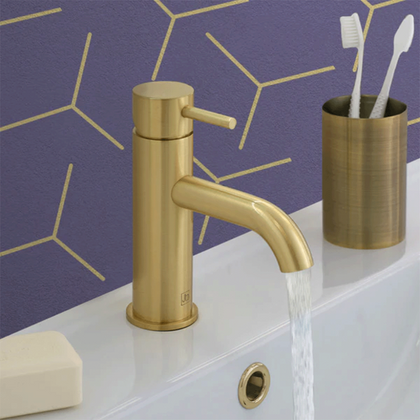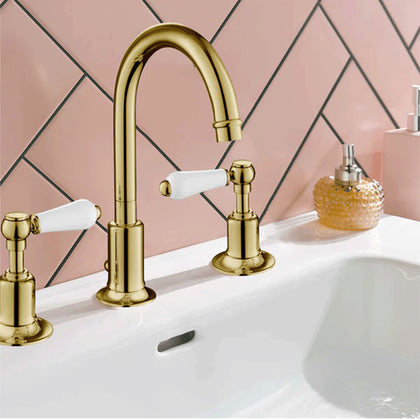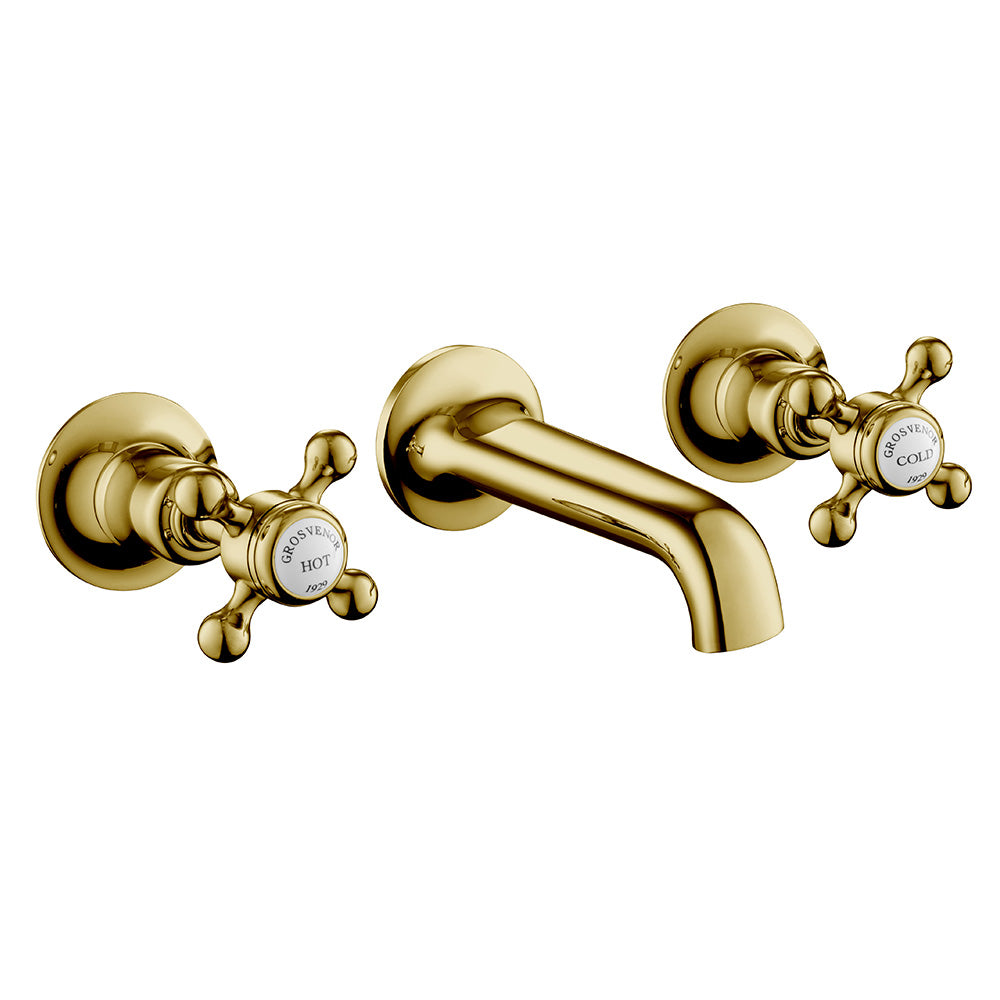Selecting a basin tap for your bathroom might seem like a straightforward task at first glance. However, without a clear idea of your preferences and requirements, it can quickly become overwhelming. There are several factors to consider, including water pressure, tap style, preferred finish, and the placement of your basin. In this comprehensive guide, we will delve into the diverse range of basin taps available on the market. From traditional to modern styles, and from different finishes to various mounting options, we'll cover everything you need to know to make an informed decision.
1. Pillar Taps
Pillar taps for basins may sound unfamiliar to some, but they are a classic fixture found in many bathrooms, particularly those with a traditional or older aesthetic. These taps typically come in pairs, featuring separate controls for hot and cold water. While they are prevalent in the UK, they might be less common in other regions, leading to confusion for visitors unfamiliar with this setup. Basin pillar taps offer a distinct charm and functionality, allowing users to control the temperature of the water by adjusting each tap individually. However, their presence may require some adjustment for those accustomed to single-lever or mixer taps commonly found in modern bathrooms. Despite their traditional roots, pillar taps remain a timeless choice for those seeking a touch of vintage elegance in their bathroom decor.
In certain regions of the world, particularly in South East Asia and Singapore, pillar taps may also be referred to as Mono Taps or Cold Taps. This nomenclature reflects their design and function, with separate controls for hot and cold water. In these areas, where the climate tends to be warm and pipe water temperatures remain comfortable at around 25-30 degrees Celsius throughout the year, pillar taps have become a common fixture in many households. However, in Singapore, the popularity of pillar taps has declined over time, particularly with the introduction of hot water supply pipes in all newly constructed flats since 1990. As a result, newer homes are equipped with systems that provide both hot and cold water, rendering the need for separate pillar taps obsolete. Despite this shift in preference, pillar taps continue to hold a place in the cultural and architectural history of the region, serving as a reminder of traditional plumbing practices.
2. Single-Hole Basin Mixer Taps
Single-Hole Basin Mixer Taps are highly sought-after fixtures in modern bathroom designs. They offer convenience and efficiency by requiring only one tap hole, simplifying the installation process and reducing clutter around the basin area. These taps feature a single spout from which both hot and cold water are dispensed, providing a seamless and streamlined look to the bathroom.
The functionality of basin mixers is further enhanced by their single lever control, allowing users to adjust both flow and temperature with ease. However, for those who prefer greater control over temperature settings, twin lever basin mixers are also available, with separate levers for hot and cold water. Basin mixers come in a wide range of styles to suit various bathroom aesthetics, ranging from traditional to modern designs. Options include square or waterfall spouts, as well as aerated models for enhanced water efficiency. Additionally, there is a plethora of finishes to choose from, with chrome being the most common choice. However, alternatives such as stainless steel, gold, and nickel finishes are also available, allowing for customization to match the bathroom's decor. The growing popularity of countertop basins has led to the emergence of tall basin mixers. These monobloc taps are designed to complement countertop basins, offering a sleek and sophisticated appearance. Unlike traditional basin mixers, tall basin mixers are installed directly onto the countertop or vanity cabinets rather than the basin itself. This arrangement not only adds to the aesthetic appeal of the basin but also creates a cleaner and more spacious look in the bathroom.
3. Three-Hole Basin Mixer Taps
Three-Hole Basin Mixer Taps offer a sophisticated alternative to single-hole basin mixers, providing enhanced control over water flow and temperature. Despite requiring three installation holes, these taps function similarly to their single-hole counterparts, with hot and cold water being dispensed through a single spout. However, in three-hole basin mixers, separate levers for hot and cold water are located in the remaining two holes, allowing users to adjust temperature settings with precision.
The inclusion of separate hot and cold levers provides excellent control over water temperature but may require the use of both hands for adjustments, especially when aiming for the perfect balance. Despite this, three-hole basin mixers offer versatility in design, with options available in both modern and traditional styles to complement various bathroom aesthetics. While three-hole basin mixers tend to be more expensive than single-hole or pillar taps, they are highly regarded for their stylish appearance and functionality. It's essential to note that these mixer taps are primarily designed for installation on countertops or vanity tops, rather than directly on the basin itself. While countertop washbasins with three holes are less common in regions like Singapore and Southeast Asia, they can be specified when ordering the washbasin.
A noteworthy variation of the three-hole basin mixer is the bridge mixer, which blends classic design elements with modern technology. In bridge mixers, the levers and spout are all connected to a single unit, resembling a bridge. This innovative design reduces the number of holes required in the countertop to two, offering a sleek and minimalist look while maintaining functionality.
4. Wall-Mounted Basin Mixer Taps
Wall-Mounted Basin Mixer Taps represent the pinnacle of modern design and functionality in bathroom fixtures. These taps offer a sleek and minimalist aesthetic by mounting directly onto the wall, eliminating clutter around the basin area and providing a clean, contemporary look. Once a feature predominantly found in luxury establishments such as hotels, spas, and high-end restaurants, wall-mounted basin taps are now accessible to homeowners seeking to elevate their bathroom spaces.
With a wide range of options available, homeowners can choose from various designs to suit their preferences and bathroom aesthetics. Traditional and modern styles are available, with options for single-temperature control and flow adjustment or separate hot and cold water handles. Additionally, consumers can select taps with or without a backplate, allowing for customization based on desired visual appeal. Taps without backplates lend themselves to a more modern, minimalist appearance, ideal for those seeking a streamlined look in their bathroom. One of the key advantages of wall-mounted taps is their versatility in basin placement. Unlike traditional basin taps that require mounting directly onto the basin itself, wall-mounted taps allow for greater flexibility in basin positioning. However, it's essential to consider placement carefully to prevent issues such as water splashing or difficulty in accessing the taps. Optimal positioning ensures both functionality and aesthetics are maintained, enhancing the overall user experience. In conclusion, choosing the right basin taps involves careful consideration of various factors, including design, functionality, and placement. By understanding the different types of basin taps available and their respective features, homeowners can make informed decisions to create a stylish and functional bathroom space. If further assistance is needed, our team is always available to provide guidance and support in selecting the perfect basin taps for your needs.
For those looking for a quick buying guide on bathroom basin taps, you can check out 'Your Complete Bathroom Basin Tap (A Quick Buying Guide)' for more detailed information.








No comments:
Post a Comment